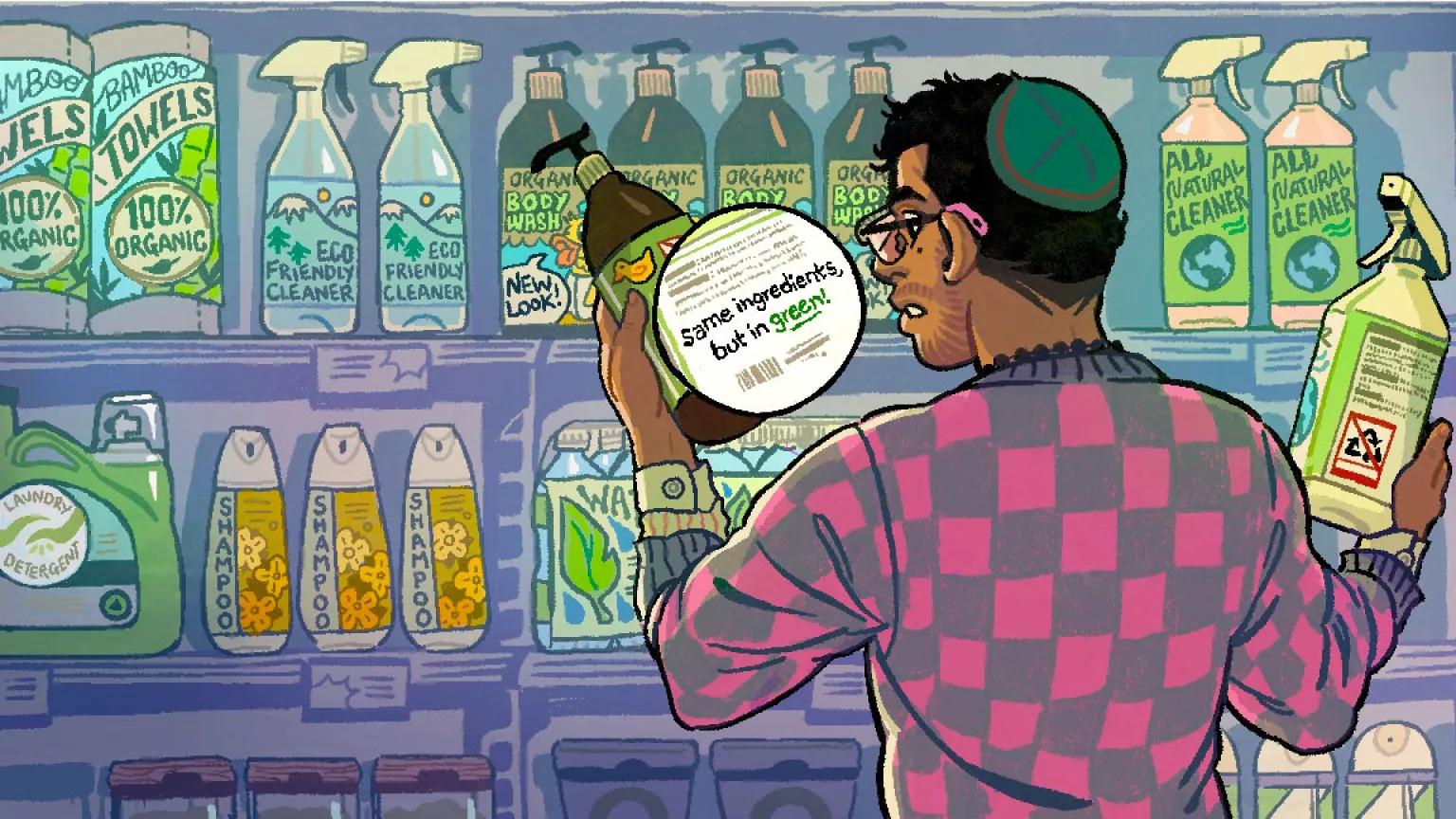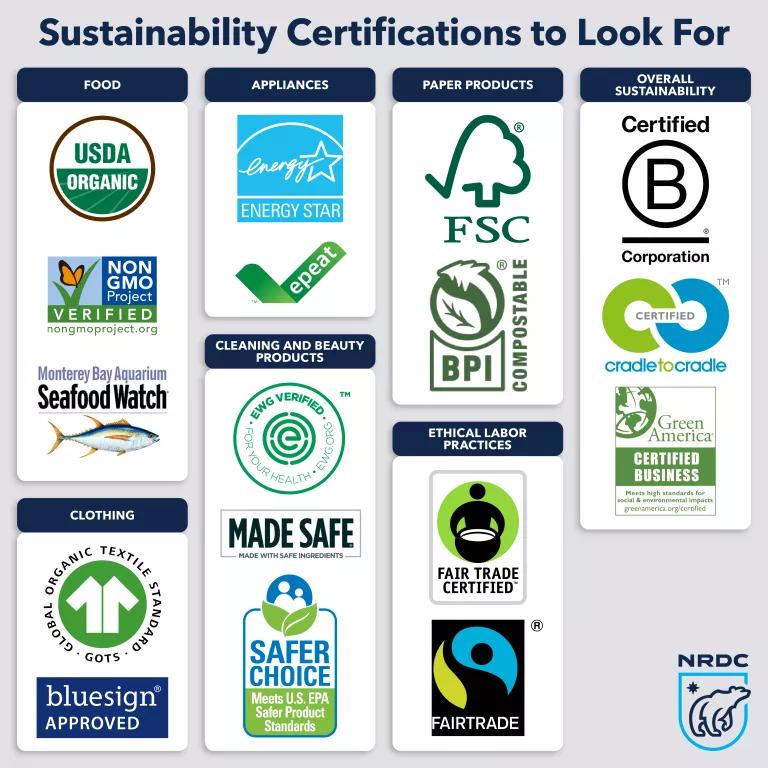Learn to Spot Greenwashing
It’s tricky to separate flimsy promises from what’s actually environmentally friendly. We can help.

Abe Erskine for NRDC
More than a third of global consumers are willing to pay more money for green products. And many are interested in supporting companies and organizations that align with such values. But just because something seems eco-friendly doesn’t mean it is.
We’re talking about greenwashing—the rampant act of companies, organizations, or even public figures making false or misleading claims about the sustainability of their products or practices. The goal: to sway consumers, public opinion, and even investors. Greenwashing can be easily apparent, but more often, it manifests in nuanced and harder-to-spot ways. Images of nature or eco-friendly buzzwords on a product’s packaging may hint at sustainability but not reflect real-world impact. So a company that runs a polluting facility may highlight its initiative to plant trees, all while hiding how its primary activities hurt air quality.
The better news is that consumers can play a role in pushing marketplaces toward more planet-friendly practices. It’s useful, of course, to be able to tell the difference. Here’s a set of guidelines that will help you learn to spot greenwashing a mile away.
Read beyond the labels.
Natural. Eco-friendly. Sustainable. Nontoxic. These words may sway consumers, but they’re vague enough as to mean different things to different people, and they offer no real proof that a product is green. Other buzzwords may signal something is green in only some circumstances. Take toilet paper, for example. Many companies tout their version as being eco-friendly because they replant trees, even though they’re still using clearcut virgin forest fiber to make their products. Broad company statements about a “commitment to protecting the planet” don’t tell us much either. Instead, look for specific details about how a company is being a good steward and if it has set concrete or near-term deadlines for any promised change.
Don’t fall for nature-based imagery.
In the same way that vague environmental words can fly under the regulation radar, companies can dress up their products with environmental images—like trees, leaves, and animals—that imply sustainability without facing any scrutiny. “As humans, we see images and we react emotionally to them,” warns Todd Larsen, the executive co-director for consumer and corporate engagement at the environmental advocacy group Green America. “You may have these beautiful nature scenes, but there’s not much behind it.” Companies can also quite literally greenwash by coloring a product or logo green. So look beyond the impression those images suggest and see if there’s any proof the product or practice is truly eco-friendly.

Pay close attention to certifications.
Independent, third-party certifications can be useful markers of sustainability. These stamps of approval, specifically by consumer advocacy or environmental groups, tend to do the vetting for you and measure various environmental indicators, like chemical usage or carbon emissions. They also clearly state their criteria and how they rate companies. The issue is, greenwashers know this and will try to mimic the practice with their own, less rigorous, versions. Take the problematic Sustainable Forestry Initiative (SFI), which was actually made up by the logging industry to create the appearance of eco-friendly practices for consumers. SFI essentially allows some logging operations to shirk participation in the widely respected (and more stringent) Forest Stewardship Council. So it’s important to know who to trust. Below are a few of the most well-regarded environmental certifications.
- Overall sustainability: B Corp Certification, Cradle to Cradle, Green America Business Network Certification
- Appliances: Energy Star, EPEAT
- Cleaning and beauty products: Environmental Working Group, Made Safe, EPA SaferChoice
- Clothing: Global Organic Textile Standard, Bluesign
- Ethical labor practices: Fair Trade USA, Fairtrade America
- Food: USDA Organic, Non-GMO Project, Monterey Bay Aquarium Seafood Watch’s “Best Choice” and similar options
- Paper products: Forest Stewardship Council, BPI
Do keep in mind, though, that even third-party certifications can have issues. As Larsen says. “You shouldn’t assume a product is perfect, even when it has a good certification.”
Consider what you’re not being told.
Companies doing the right thing will be happy to tell you about it, and it should serve as a red flag if they’re not. The same goes for companies that choose to selectively broadcast green initiatives, which is often a form of distracting from their broader environmental impact. Gina Ramirez, Midwest outreach manager at NRDC, saw this play out when she heard about a proposal to build a mine in her residential neighborhood on the Southeast Side of Chicago. The company behind the project tried to bill the mine as a “subsurface real estate complex” and potential location for green industry, but Ramirez saw right through it. She asked to see studies on the expected impacts on air quality or traffic. Unsurprisingly, the company came up empty-handed. “You should always ask questions,” Ramirez says, “especially if it’s not something the community asked for in the first place.”
What you can do to combat greenwashing
Learning how to spot greenwashing is a big first step, but there are other ways you can also be an advocate for truly green companies and policies.
- Look for companies with a cause: Read up on a company’s history to learn about its origin story and guiding principles before supporting it. “A lot of the best companies out there in the green space are small companies that started with a mission of being sustainable, socially responsible, or both,” Larsen says. “If you look at a large company, some of what they’re trying to do might be genuine, but it’s not integral to how the company was set up and run.”
- Speak up: Greenwashing is a way to manipulate consumer opinion and public image. Counteract it by talking about the products and businesses making misleading claims. Take to social media and tag the greenwashers—you may spark an important public dialogue. You can even demand accountability directly. In a recent example, hundreds of thousands of people signed a petition to the CEO of Procter & Gamble to make more sustainable tissue products. And finally, there’s always the option to file a complaint directly with the Federal Trade Commission (FTC).
- Support legislation: In the United States, the FTC is in charge of monitoring false or deceiving marketing claims, but since the early 1990s, it’s gone after violators fewer than 100 times. Encouragingly, the agency is looking to update its “green guides,” which will better define what constitutes as false environmental marketing. For the long term, you can support legislation that tackles false marketing and push your elected officials to pass even stricter protections because, ultimately, it should not be on consumers to parse out who is telling green lies.
- Trust your gut: Research indicates that simply being aware of greenwashing and its prevalence helps us remain skeptical when we come across potential examples. Andreas Rasche, a greenwashing expert and professor at the Copenhagen Business School, also encourages his students to rely on common sense when it comes to manipulative marketing because, at the end of the day, he knows it’s impossible for consumers to learn everything they need to know about every industry to spot all greenwashing. “If you buy a T-shirt for one euro in these very cheap stores, and it says it’s eco-friendly, your common sense tells you that that cannot be,” Rasche says. “I think a lot of it comes down to being reflective. If you do this as a consumer, you’ve already achieved a lot.”
This NRDC.org story is available for online republication by news media outlets or nonprofits under these conditions: The writer(s) must be credited with a byline; you must note prominently that the story was originally published by NRDC.org and link to the original; the story cannot be edited (beyond simple things such as grammar); you can’t resell the story in any form or grant republishing rights to other outlets; you can’t republish our material wholesale or automatically—you need to select stories individually; you can’t republish the photos or graphics on our site without specific permission; you should drop us a note to let us know when you’ve used one of our stories.



When Customers and Investors Demand Corporate Sustainability
“Chemical Recycling” Isn’t Actually Recycling.
Wildfires Can Spark Widespread Contamination of Public Water Supplies